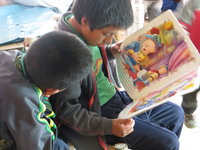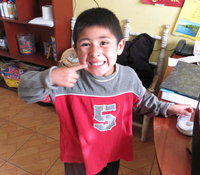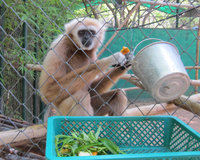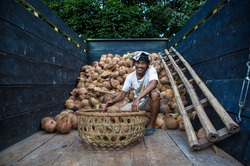
For the second part of my Peru trip I headed south to the sunshine city of Arequipa to visit the orphanage project. Guarded by three volcanoes the “white city” has a picturesque backdrop and with beautiful colonial architecture it is not hard to see the charm this city has on travellers.
Becky, Placement Manager
The orphanage that we work with in Arequipa offers care for approximately 15-20 children under the age of 10 who have been placed by the government having lost one or both parents, been morally and/or materially abandoned or who have been deemed at social risk by the government.
The orphanage is run by full time Peruvian volunteers – calledtias (aunties) - who get only food and board for their work. The orphanage works with the government, who sends them children, but no money or resources. The Director, Delia, places great emphasis on trying to get the children back into their family home when it is safe to do so or, where this is not possible, into an extended family home, with adoption as a last resort. If possible the orphanage should only provide a temporary home for the children where they can be cared for and receive good nutrition, clothes and educational support.
I visited the orphanage on my first day and was blown away by the work that the tias are currently doing. The orphanage at this moment in time has 16 children; one very small baby (2 months) seven under 3 years, eight “older children” aged between 4-10. Anyone who has previously worked with babies and toddlers will know that just one or two babies in a room can be a chaotic handful – this cheeky bunch are certainly no different!
An average day at the orphanage
Volunteers are scheduled into two shifts; morning and afternoon. Both are long shifts of around 5 hours and so you only do one per day (5 per week).
For the morning shift, volunteers need to arrive at the orphanage for 7am which meant a painful 5:50am alarm clock! The journey to the orphanage takes around 30-40 minutes depending on the traffic so we left the house at 6:50am to walk down through early morning Arequipa and catch the local bus for approx 16p in British terms. The journey is a nice chance to wake up and a great way to see the city coming to life.
On arrival you immediately swing into action as the children are usually up and about and ready for breakfast. The tias get the children up and dressed and prepare the breakfast for them all before 7am (if everything runs to plan!) however volunteers can get stuck in at 7am to relive the tias and ensure the babies are all in highchairs, eating (not throwing) food and that the kitchen washing up is not in backlog. After breakfast the older children head off to school and volunteers and tias focus attention on the babies. Tasks include washing clothes, sorting clothes (a bigger job than it sounds), sweeping, mopping, clearing rooms, washing dishes, feeding the children, changing dirty nappies and of course playing with the children and encouraging their development. In the morning they are also joined by a child development specialist who does an hour of songs and activities with the babies and toddlers to ensure they are engaged and are developing their motor skills. This time is the perfect opportunity for volunteers to get the chores done without being interrupted! At 12pm the children sit down for lunch and volunteers can start to pack up and head back to the volunteer apartment (or into town!) for lunch and enjoy the rest of their day.
The afternoon shift starts at 1pm and volunteers usually arrive to a full house as the older children return from Primary School at lunchtime. Generally the small babies will be waking from their naps at this time so changing nappies and clothes can also be necessary, it is then play time and homework time for the older children. With so many babies around it is easy for the older children to be left out and so it is great if volunteers can sit with them to help with homework, for beginners in Spanish maths is the easiest to help with but if you have some Spanish under your belt then other subjects can be tackled – a dictionary is useful for this! After dinner time volunteers help with pyjamas and nappies and then it is bedtime. Volunteers usually leave around 6pm however the tias are always thankful when you can be flexible on this.
Relaxing in the volunteer accommodation
Although the work at the orphanage is very hard, the volunteer accommodation and location in Arequipa definitely compensate as you can truly embrace your free time. The volunteer apartment is located within a Spanish School for travellers run by Sofia, the Project Coordinator, and so the atmosphere in the house is fantastic. The garden is full daily with people from all over the world practicing their Spanish with one-on-one tutors and everyone is eager to talk to you and get to know you – volunteers and Spanish students alike. The apartment has a terrace overlooking the garden, two bathrooms, WiFi and a TV with DVD player. Many of the volunteers have chosen to get Spanish lessons downstairs to complement the volunteer work and help with interacting with thetias at the orphanage. Sofia also arranges Peruvian Cookery Lessons and trips and tours in the local area so she can help advise volunteers on everything they need.
Sadly as my stay was so short I was unable to take language lessons however I did get stuck in with the cookery, making the famous Arequipeño dish Rocoto Relleno (stuffed rocoto peppers) and the formidable Pisco Sour and arranged a trip to the Condor Cross in the Colca Canyon on my final day.
The big fundraising drive
The orphanage is doing intensive fundraising to finance the construction of a new home. Currently the orphanage is located in a three storey house in Arequipa however the house belongs to a friend of the director and at this time they need to have the house returned. Thanks to many kind donations, work begun on a new purpose-built home in August 2013 and on my first day in Arequipa I was able to visit the site to see how the building has progressed. The walls and shape of the first floor is now clearly visible and the director was happy to show us the architectural plans of how it will develop in time – it will be a fantastic home for the children but something that will take a few years more to complete. Thankfully the current property is not on a time limit so for the meantime the children, tias and volunteers will all be staying here for the next few years but it is great to see the orphanage planning ahead for the change. If you would like to donate towards their fundraising efforts please see the PoD Charity Page.
How you can help
The orphanage is always in need of help from volunteers, the work load involved in caring for 20 young children is never ending and so if you would like to volunteer here we would love to hear from you. You can read more about the orphanage volunteer role on the project page or click here to apply now!






 RSS Feed
RSS Feed